Posts Tagged recipes
German Bread Recipe & Guide to Stoneware Bread Cloche Cooking
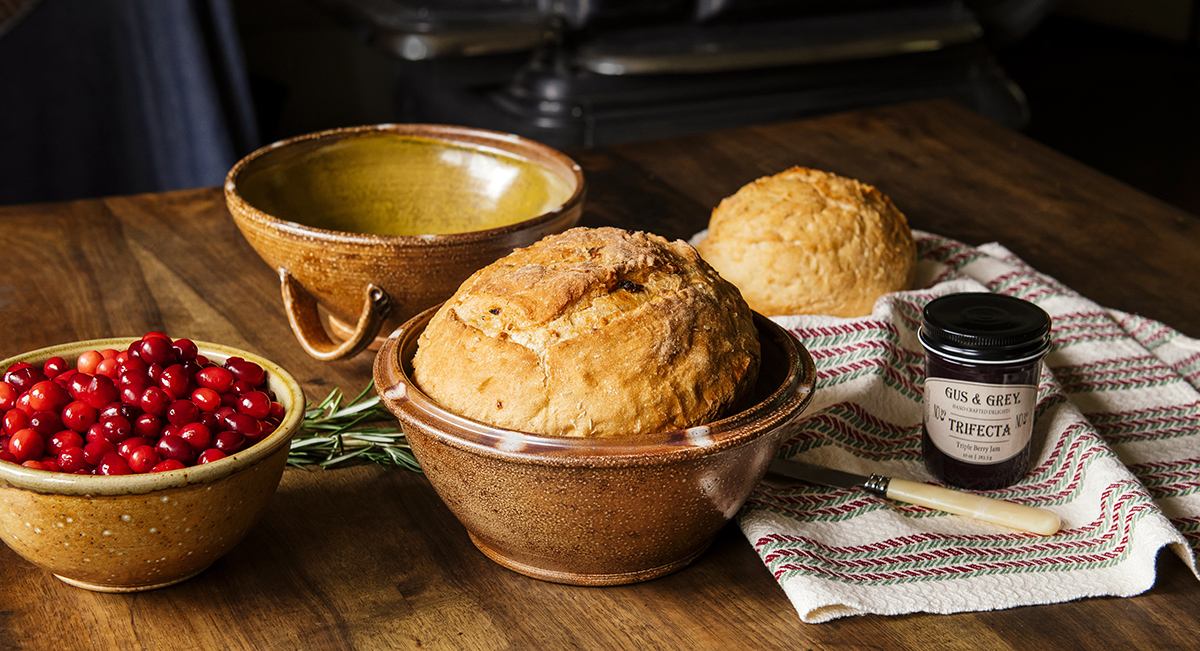
Our handcrafted and salt-glazed stoneware bread cloche allows you to mix your dough, proof it, and then bake it all in one dish. During the baking process, the lid traps steam, creating bread that is light and airy with a golden crust. Salt-glazed stoneware was a popular kitchen staple in the early 1800s as the firing process resulted in a surface that was both durable and beautiful.
German Bread Recipe
Ingredients:
- 1 pint bread sponge (To make a bread sponge, dissolve 2 tablespoons sugar and 1 teaspoon active dry yeast in 2 cups warm water)
- 1 cup sugar
- 1 egg
- 3 tablespoons melted butter
- 4 cups flour (Keep an additional 1 to 2 cups on hand as needed)
Directions:
- 1. Beat together the bread sponge, sugar, egg and butter until you have a light mixture.
- 2. Stir in flour until the mixture is thick. Begin with 4 cups and then add 1-2 additional cups as needed.
- 3. Grease interior sections of the bread cloche and pour in the mixture.
- 4. Cover the cloche and let the dough rise until it doubles in size (roughly about an hour).
- 5. Open the cloche and punch the dough down.
- 6. Re-cover the cloche and let the dough rise a second time (about 30 to 45 minutes).
- 7. Bake covered in a moderate oven (350 F for 25 to 30 minutes).
This recipe and cooking technique are demonstrated onsite at Firestone Farm in Greenfield Village.
Source: The Household of the Detroit Free Press, 1881, p. 386; edited for modern use by The Henry Ford Living History Leadership.
My friend Jennifer introduced me to Marian Morash’s The Victory Garden Cookbook (Alfred A. Knopf, 1982) in 2022. She explained that the cookbook was her mother's go-to wedding present. When Jennifer and her daughter saw a feature article about Mrs. Morash and her husband in Better Homes & Gardens (2017) they wrote her. They thanked her for the inspiration the cookbook provided three generations of cooks in Jennifer's family, and the modest Beard-Award-winning chef, author and TV personality wrote back, amazed that the cookbook could still be found.
Marian’s inspiration came from none other than Julia Child who passed along partially cooked foods from a cooking show that Marian’s husband, Russell Morash, piloted in 1962. The following summarizes the connections that laid the groundwork for the influential Victory Garden Cookbook.

Dust jacket, The Victory Garden Cookbook (1982). / THF708642

Hardcover, The Victory Garden Cookbook (1982). / THF708645
Morash's Background and Inspiration
Morash’s husband, TV producer Russell Morash, first encountered Julia Child, co-author of Mastering the Art of French Cooking (1962), on the WGBH-TV show I’ve Been Reading, in an episode likely broadcast on February 19, 1962. Child captivated WGBH-TV staff and viewers with her cooking demonstration, and the station decided to produce three pilot episodes of The French Chef. These aired in 1962 on July 26 (the omelet), August 2 (coq au vin) and August 23 (the souffle). The new series, The French Chef, debuted February 11, 1963. Marian’s husband, Russell Morash, produced the new series. The half-prepared recipes that Russell salvaged from the show, along with Julia Child’s directions written to Marian so she could complete the cooking, nurtured the nascent chef. In 1975, Marian co-founded Straight Wharf Restaurant in Nantucket, Massachusetts, and ran it as executive chef. Continue ReadingWe The People Opportunity Farm and Plum Market Kitchen at The Henry Ford

Melvin Parson Gardening during the Entrepreneurship Interview, April 5, 2019 / THF295401
Our culinary team at The Henry Ford is continuously inspired by the stories we tell from our collections and the modern-day changemakers we have the privilege to work with. We’re also always looking for partners whose goals mesh with The Henry Ford’s goals for our food programming. Executive Chef David McGregor of The Henry Ford notes those include “understanding the connection that we have with the food we consume and passing this knowledge down to future generations to ensure a sustainable food system,” as well as “taking the time to understand the seasonality of the food grown in your region and building relationships with local farmers and artisans to create menus that reflect that availability as the seasons change.”
Last year the team created a series of recipes inspired by the work of George Washington Carver; this fall we worked with local farmer and social entrepreneur Melvin Parson, utilizing the products from his farm at The Henry Ford in Plum Market Kitchen. Parson is no stranger to The Henry Ford. As the founder of We The People Opportunity Farm, he was the Spring 2019 Entrepreneur in Residence at The Henry Ford, funded by the William Davidson Foundation Initiative for Entrepreneurship.
Learn more about Parson and his vision for change:
- How Melvin Parson Created an Urban Farming Initiative
- Melvin Parson: Market Gardener and Social Entrepreneur
- Innovation Journey with Melvin Parson
- Agriculture Pioneer Melvin Parson
We worked with Parson and his farm this fall to provide locally sourced ingredients in our restaurants, like those found in our Heirloom Tomato Salad with White Wine Vinaigrette. Enjoy it during a visit to Plum Market Kitchen, and then try making it on your own at home.
Heirloom Tomato Salad with White Wine Vinaigrette (serves many)
Ingredients: Tomato Prep
- 15 heirloom tomatoes
- 2 yellow onions, julienned thin
- 1 cup white wine vinaigrette
- 1 cup basil chiffonade
- 1 tbsp salt
- 1 tsp black pepper
Ingredients: Vinaigrette
- 2 cups olive oil
- 1 cup white wine vinegar
- 6 garlic cloves, minced
- 1 tbsp fresh parsley, chopped
- ½ tsp dried basil
- 1 tsp kosher salt
- ½ black pepper
METHOD: Salad
- Cut tomatoes into 1” chunks and place in a colander for a few minutes to drain excess moisture.
- Place tomatoes in a large bowl with other dry ingredients.
- Fold in Dressing for service, being careful to keep the tomato pieces intact.
METHOD: Vinaigrette
- Add all ingredients except oil and blend until smooth
- Slowly add oil while blending until everything is incorporated.
Lish Dorset is former Marketing Manager, Non-Admission Products, at The Henry Ford.
by Lish Dorset, farms and farming, entrepreneurship, recipes, restaurants, food
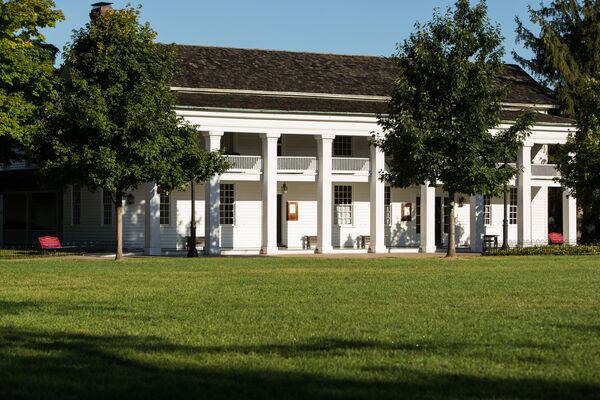
Photo by KMS Photography
When it comes to dining experiences, Eagle Tavern in Greenfield Village is one of a kind. The stagecoach tavern was built in 1831 in Clinton, Michigan. Calvin Wood and his wife Harriet operated it from 1849 to 1854, offering food, drink, and accommodations to the locals and those who came through the town. In 1927, Henry Ford purchased the tavern and brought it to Greenfield Village as the Clinton Inn, where it first served as a cafeteria for Edison Institute students and then for visitors. In April 1982, Eagle Tavern officially opened as the restaurant we know today. Forty years later, Eagle Tavern continues to delight members and guests with mid-1800s food and drink.
As we celebrate the beginning of the 2022 Greenfield Village season, Sous Chef Kasey Faraj shares three of his favorite Eagle Tavern recipes for you to try at home.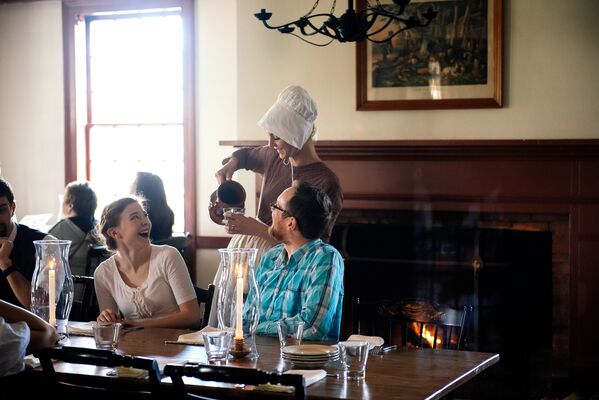
Photo by Emily Berger
“My absolute favorite thing about the tavern is the overall guest experience,” said Faraj. “There is simply no place like this anywhere in America where we are taking our guests on a journey to the past. Everything from our Calvin and Harriet Wood characters chatting with our guests to the food, to the look of the bill of fare and restaurant, and the servers in period clothing, we all collectively create an experience that is unique, historically accurate, and unmatched by any establishment.”
Faraj found inspiration for his menus from classic mid-1800s era cookbooks, like Mrs. Putnam’s Receipt Book and The Kentucky Housewife. It was in these wonderful books that he was inspired to create dishes such as our delicious Asparagus Soup, Pork and Potato Balls, and Bouilli Beef.
Eagle Tavern’s Asparagus Soup
serves many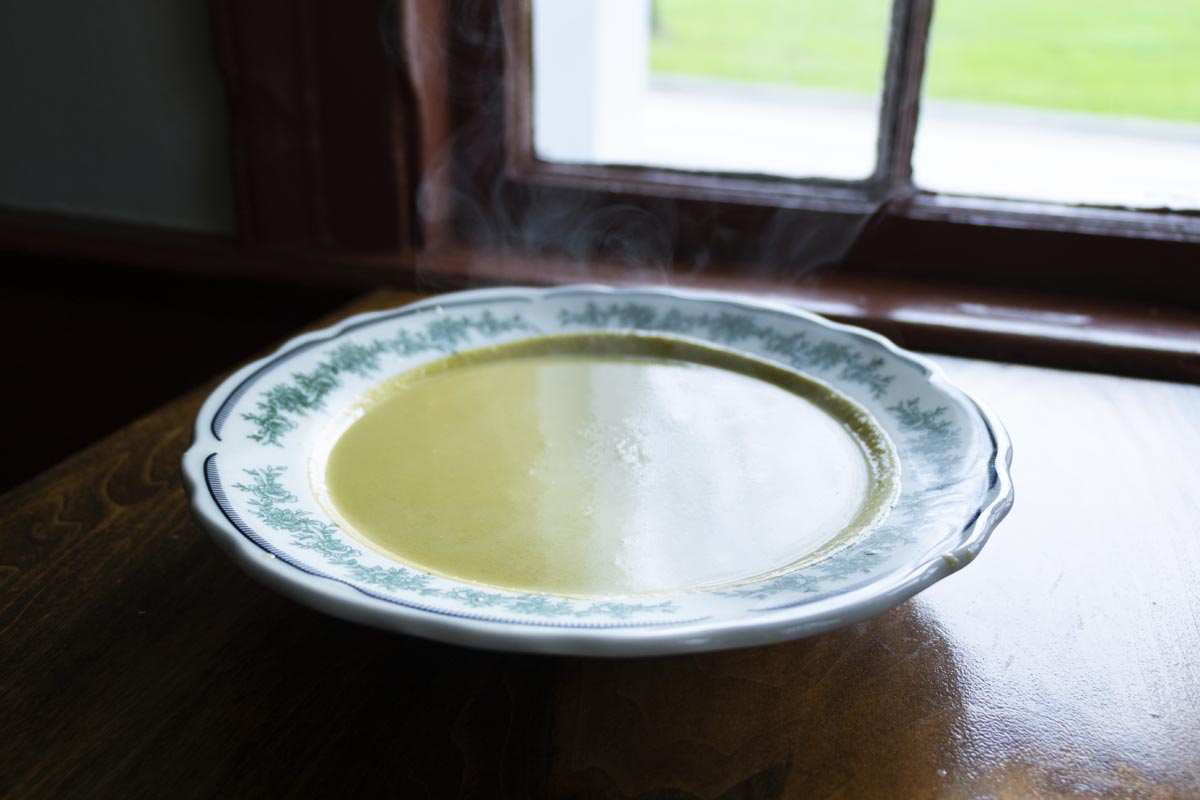
Ingredients
- ½ pound unsalted butter
- 1 ½ cups yellow onion, medium dice
- 1 teaspoon fresh garlic, minced
- 5 pounds asparagus, trimmed
- 1 ½ cups celery, diced
- 2 bay leaves
- ¾ gallon vegetable broth
- ½ cup cornstarch
- 1 quart half-and-half
- Salt and pepper to taste
Method
- Heat a stockpot and melt the butter.
- Add the onions and garlic and cook over medium-high heat until onions are translucent.
- Add the asparagus, celery, bay leaves, and vegetable broth. Bring to a boil.
- Once boiling, turn heat to low and simmer until asparagus is tender.
- Add the cornstarch and half-and-half and puree the mixture with a hand blender until smooth. (You can also slowly break down the asparagus with a potato masher.)
- Add salt and pepper to your liking.
- Adjust the cornstarch if thicker or thinner soup is desired.
- Strain if you wish to have a lighter-style soup. Serve with fresh bread or crackers.
“The awesome curators here at The Henry Ford and I collaborate to find these menu items in cookbooks from the past,” said Faraj. “I then take said items and build the menu through both seasonal availability and the story of Harriet and Calvin Wood. It is not as simple as, ‘I found a recipe for a mid-1800s era style corn soup, so we are going to offer that soup.’”
Faraj and team take everything into consideration:
- How did season and local availability influence the meals that a tavernkeeper like Harriet Wood might have prepared for her tavern customers?
- What foodstuffs could have been imported in southern Michigan in 1850?
- What type of meals and desserts might Harriet Wood have had time to prepare over an open hearth in her busy tavern kitchen?
“In-depth research from period American cookbooks found in our research center, and expertise from our curators, help us find our way to these answers,” he said. “The ability to find a recipe from a book written almost two centuries ago, test that recipe, and then place it on a menu (that is seasonally accurate!) is what makes a chef working in historic dining challenging—yet fun!”
Eagle Tavern’s Pork and Potato Balls
serves many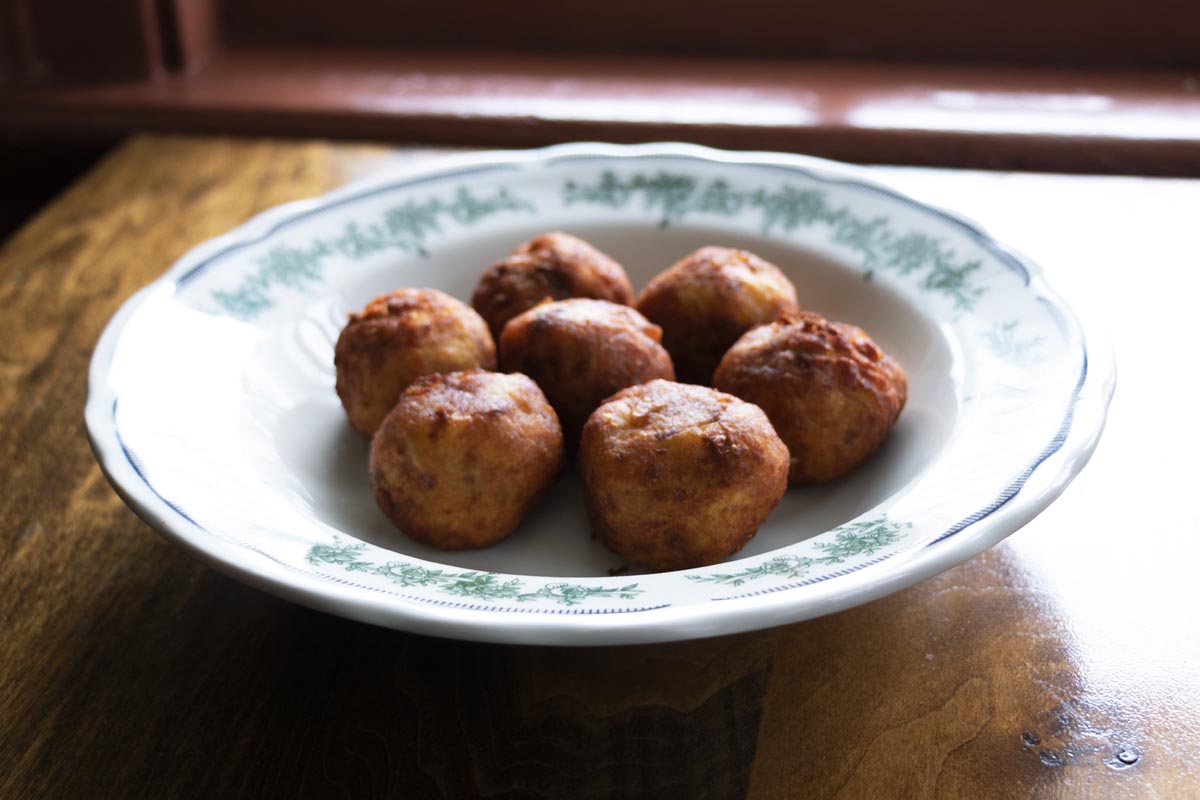
Ingredients
- 3 pounds cooked Idaho potatoes
- 3 fresh eggs
- 1 pound cooked pork-sage sausage, crumbled
- Salt and pepper to taste
- 1 pound unsalted butter
Method
- Put cooked potatoes in a large mixing bowl. Using a potato masher, mash the potatoes until there are very few lumps.
- In a separate bowl, whisk the eggs.
- Add the crumbled sausage, salt, and pepper to the eggs and mix until evenly distributed.
- Using a spoon or a small scooper, shape the mix into small balls no larger than a golf ball.
- Heat a nonstick pan and melt the butter.
- Cook the balls in the butter until browned on all sides and the internal temperature is 165° F. When cooked, sprinkle with additional salt and pepper and serve with extra butter, if desired.
One last recommendation from Chef Faraj: Eagle Tavern’s Bouilli Beef. “This dish is great served with roasted potatoes and mashed parsnips,” he said.
Eagle Tavern’s Bouilli Beef
serves many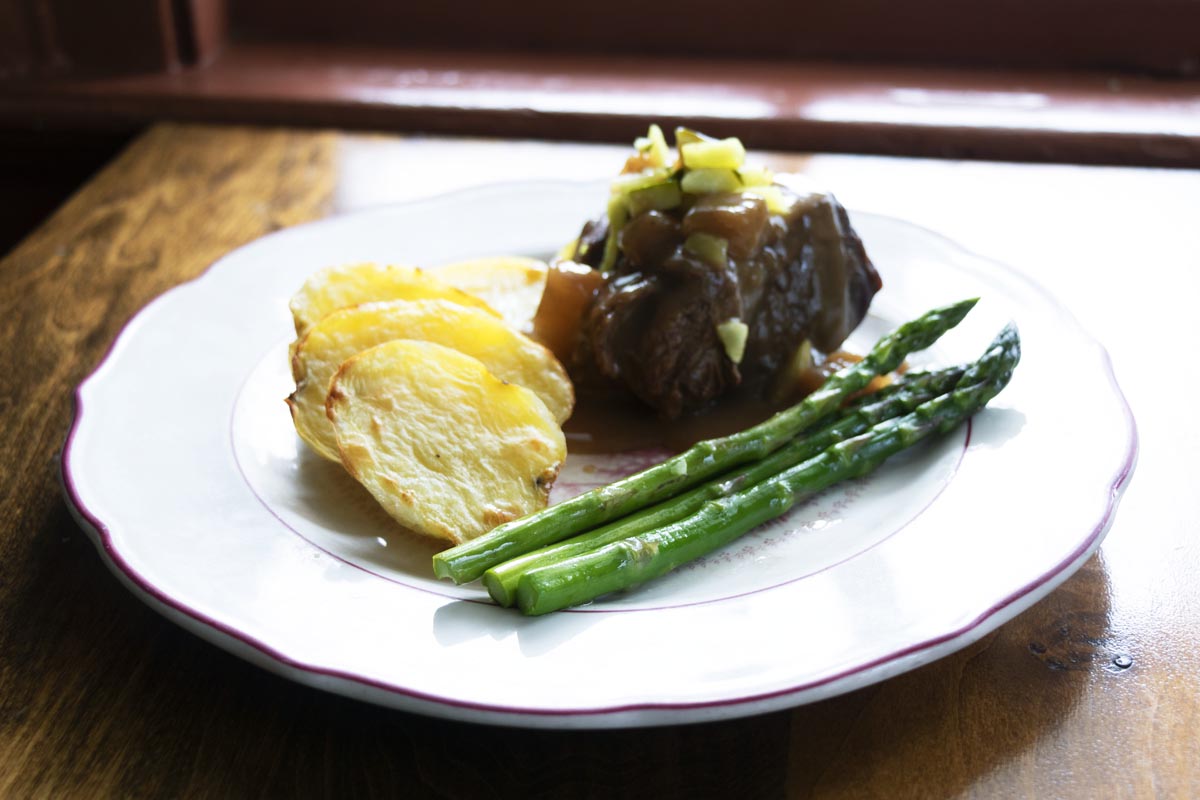
Ingredients
- 3 pounds beef, cut into 8-oz. portions (preferably chuck eye roll)
- Salt and pepper to taste
- 3 ounces vegetable oil
- 1 pound turnips, cut into 1-inch pieces
- ¼ pound yellow onion, medium dice
- ¼ pound peeled carrots, medium dice
- ¼ pound celery, medium dice
- 1 ½ gallons beef stock
- 2 bay leaves
- ½ teaspoon ground cloves
- 6 cloves fresh garlic
- 1 ounce soy sauce
- 2 ounces Dijon mustard
- 4 ounces cornstarch
- 4 ounces chopped sweet pickles
Method
- Season the beef with salt and pepper. Heat the vegetable oil in a stockpot on the stove and sear the meat on all sides.
- Add the rest of the ingredients except for the soy sauce, mustard, cornstarch, and pickles.
- Bring it all to a boil; once boiling, turn the heat down to a low setting and cover. Let cook slowly until the meat is almost fall-apart tender, 2-3 hours. Turn off and leave on stove.
- Take half the stock the beef was cooked in and strain. Whisk together the soy sauce, mustard, and strained stock in a small saucepot over medium heat. Add the cornstarch and bring to a slow boil; cook until gravy is slightly thick. Add the cooked beef and plate with the turnips it was cooked with.
- Ladle 2-3 ounces of gravy over each piece and top with chopped pickles.
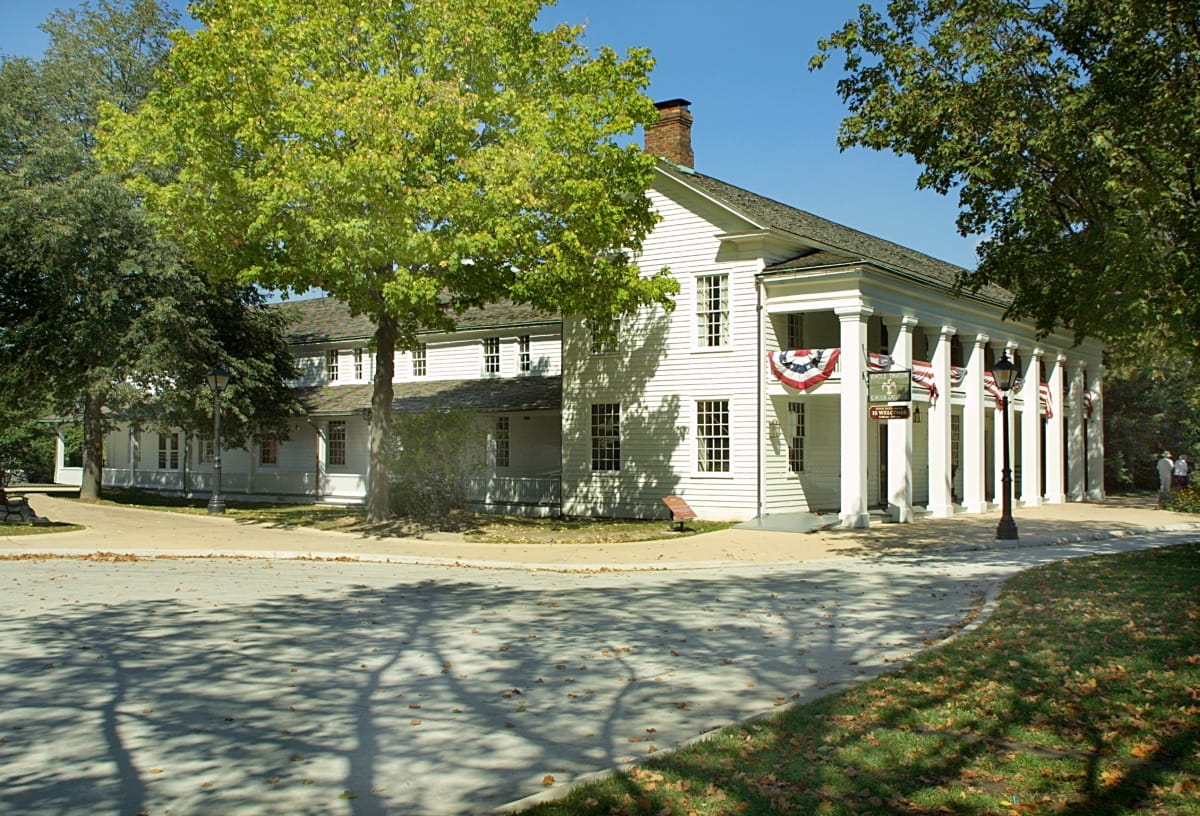
Eagle Tavern, Greenfield Village / THF1918
Want to learn more about Eagle Tavern? Look below for links to blog posts, Innovation Nation segments, and artifact records.
All About Eagle Tavern
- Artifact Record: Eagle Tavern
- Plan Your Visit
- Creating the Eagle Tavern Dining Experience
- The Henry Ford’s Innovation Nation: 1850s Dining Experience at Eagle Tavern
- 1988 Eagle Tavern Cookbook
Drink Recipes
Dig Deeper
- Greenfield Village Building Makeovers
- Meet Calvin Wood
- Drinking at Eagle Tavern
- Root Vegetables, Now & Then
- Behind the Bar at Eagle Tavern
Lish Dorset is Marketing Manager, Non-Admission Products, at The Henry Ford.
making, Michigan, recipes, food, restaurants, by Lish Dorset, Greenfield Village buildings, Greenfield Village, Eagle Tavern
All Things Food: Cookbooks and Recipes

The Henry Ford’s first edition of Julia Child’s consummate classic Mastering the Art of French Cooking, published in 1964. / THF621455
On the first Friday of every month, the collections experts of The Henry Ford share items from our archives and library collections on our Instagram account as part of our History Outside the Box virtual program. Though the Instagram stories are only available for 24 hours, we share them afterwards as videos so you can catch up on what you missed. For March, Librarian Sarah Andrus shared a sampling of the wide array of cookbooks, recipe booklets, and handwritten recipes that have found a home in our collections. Check out her selections below.
Continue Reading
History Outside the Box, by Ellice Engdahl, by Sarah Andrus, recipes, books, food
Cooking in Greenfield Village: Lessons from Master Presenter Cindy Melotti

Baking at Daggett Farm. / Photo courtesy Cindy Melotti
Recently, I sat down with Master Presenter Cindy Melotti, house lead at the Ford Home, to chat with her about 17 years at The Henry Ford. In the first installment of that interview, Cindy talked about her teaching background, her work at the Ford Home and other Village buildings, some of her favorite interactions with guests, and more. In this second installment, she offers insights about how historic cooking in Greenfield Village is far different than modern cooking at home.
What was it like cooking in the village? Did you notice any difference cooking at Daggett, say, and cooking at home?
When I first started as a presenter, I had never baked bread or made a pie before. I was a working mother, so I didn't have time to play around. I used the typical shortcuts. So it was a shock working that first season at Daggett [Farmhouse] and baking loads of bread and pies. Placing these on the table for us to eat for our 1760 mid-day meal and having guests come in and say it was the most beautiful pie crust or bread they’ve ever seen—I experienced such a sense of accomplishment.
I would go home and brag about making the most wonderful loaf of bread, a pie, or a tart. So, I decided I was going to make these same recipes for Thanksgiving dinner at home. I made the pie crust, and I made wheat bread and… I need to tell you that my husband is still living. Because he said: what was so special about them? Sadly, they didn’t turn out the same. Making bread or a pie in a bake kettle on an open hearth, it's not the same product you get using the same recipe in modern oven.
With the bread and pie baked in the modern oven, I couldn't taste all the flavors. I didn't get the flakiness, and it just wasn't the same. There are some things that you can make in a modern oven, and there's no problem. But there are other things that—you know, when you roast something today, you're actually baking it, right? At Daggett using the open hearth, when you roast something, it's on the spit or the small game roaster that you place against the fire and keep turning it. You can’t get that same flavor. When you go from the open hearth, to wood, to coal, to gas, to electric, and to microwave—every time you go up that ladder, you lose flavor. So, your best flavors come from open hearths or open-air cooking. That's why camping is so much fun.
I think part of it too is the cast iron, like at the Ford Home, where we use cast iron pans and pots that are very well seasoned. We do have a couple of cast iron artifacts that we use there. I mean, it takes 100 years or so to get it that seasoned. You can't buy one off the rack. You can’t get the same flavor. And it might have something to do with the moisture and wood smoke that gets in, because it's not hermetically sealed off like a modern oven is. There's no question many of the recipes cannot be duplicated. They’re good, but they're not what it's like when you're there at that table with the ambience of the time period.
Do you have any further observations about the differences between historical and modern recipes and cooking methods?
Yes, guests might think that because a recipe is from a long time ago, from Daggett in 1760 for instance, that it’s easier to make. That recipes are more complex now than they were in the 1700s. But they’re not. For example, our recipes at Daggett are written in the hand of that century, where they use the long “s” that looks like an “f.” And they use such odd quantities, you sometimes have to have a group discussion to figure out what they're trying to tell you about making the recipe. So recipes at Daggett are very often much more difficult than ones at the Ford Home from 1876.
Of course, it’s difficult at the Ford Home making special recipes for Holiday Nights [in Greenfield Village]. But your everyday dishes for 1876 are pretty basic and easier to make. There isn't a tendency in the 1800s to use a lot of herbs, for instance, as they did in the 1700s. So even for your meat at the Ford Home, you basically use salt and pepper, and there's a lot of lard to flavor it. The food is good, but it's not using difficult flavorings like rosewater and all these other things we use at Daggett or the Giddings [Family] Home. Recipes from the 1700s are much fancier than what I put on my own table.
Also, cooking methods in the 1700s had more challenges in the kitchen. In the Ford Home, we have a better understanding of what measurements are needed. In Daggett’s time, they're making huge amounts of food as opposed to what a family would need in the 1800s. For instance, they did all their baking in one day, and they didn't bake more until they needed it.
When you’re cooking on the open hearth or with a wood or coal burning stove, how do you know when food is done? Can you talk more about how to cook using these methods?
When I talk about cooking with guests, what they really want to know is: “how can you successfully cook like this?” And it's not hard, but you need to use all your senses, unlike how we cook today. You feel the temperature of the stove or bake kettle radiating on the skin of your face and your hands. This gives you a hint about the temperature and when you need to add more fuel to the fire. On the hearth, you can see it. But with the wood burning stove, you feel when you have to put more wood in.
To find out how your food is cooking, you use your sense of smell, and you can look and see how something's cooking. But your ears help too, because you can hear if something is over boiling or if it's boiling at all. There’s even a recipe for something that says: cook until you hear it sizzle. That was part of the recipe, to listen to it. Of course, you taste it to see if it's done. So the biggest difference with cooking in a historical kitchen is that you are actively engaged with all your senses in the process. We don't do that now. We set timers. We walk away because we can.
It's fun as a presenter to do on a daily basis. But would I want to do it every day again? I don't think so. And it's also fun for us to cook because we have guests coming into the homes. And we share what we're doing, how we're doing it, and why. I get the best reactions from guests when we have difficulty with something because it's not common to what we do. They love to see how we solve these problems that we've never faced before, because we don't cook like this all the time.
Holiday Nights in the Ford Home, with a Charlotte Russe dessert on middle-right side of table. / Photo by Ken Giorlando
What is the most difficult recipe at the Ford Home?
Charlotte Russe is probably the most difficult thing to make. We display it on the dining room table during Holiday Nights. It’s a sponge cake that you cut into strips, and you line the sides of a mold with the strips. And then you place raspberry or strawberry jelly or jam at the bottom of the mold. Then you make homemade custard and put it in the center and let it firm up.
It's a tricky little recipe to get to turn out right and come out of the mold. We finally figured out after all these years a good way to do that. We flip it over onto a plate and leave it out for a while. And once the mold is off, we put it back in a really cold place. So it stays firm as we display it on the table.
There are other recipes from the Ford Home that are my favorites. Of course, there's the pumpkin fritters that are just to die for.
Frying pumpkin fritters on the set of Live in the D on WDIV Local 4 in 2017. / Photo by Jim Johnson
Speaking of pumpkin fritters, I remember you appeared on a local news show where you made them in their studio kitchen. Can you tell me more about that experience?
Ah, yes. That was so fun. It was Fall Flavor Weekends in 2017, and the first weekend was already over. It was a Monday afternoon, and I was working at Daggett with two of our other talented presenters, Kellie and Erica. And Mary Weikum, who manages domestic life, stopped by and asked if I wanted to be on television the next morning at 10 a.m. on WDIV Local 4. She suggested I make the pumpkin fritters from the Ford Home with some extra batter we had. So, I agreed to do it.
| Recipe for Pumpkin Fritters (1890) |
| One pint of flour, one of buttermilk, half a teaspoonful of salt, one of soda, half a cupful each of molasses and stewed pumpkin, two eggs. Fry quickly in plenty of lard. Serve hot with sugar and cream. |
| —From Larry and Priscilla Massie, Walnut Pickles and Watermelon Cake, 1990, p. 291 |
And then I looked at Erica and Kelly and said: “what have I got myself into?” They both encouraged me and said: “Cindy, you do this 1,000 times in a day, just be yourself.” I thought, I can do that. But then again, it was difficult having to think through all of the preparations. We had to get the ingredients, and the appropriate historic utensils and bowls. To think of all those things, then be down there by 9 a.m. and then cook on television, it was daunting. Fortunately, [The Henry Ford staffer] Jim Johnson came with me, and kept me calm.
One of the funnier parts I remember was making a reference to lard and emphasizing that’s how the pumpkin fritters are made. Two of the show’s hosts went into an uproar about how they can’t eat lard—yet they obviously wanted to try some. I mean, they were just going on and on about lard when we were not on camera. So that's why I make this little reference on camera to say, yes, we fry them in lard! And then later on, I could hear them hollering “lard” across the studio while cameras were rolling. Oh my gosh!
Tati Amare, a Live in the D host, made more batter while we were frying them in the studio kitchen. After the hosts tried them, they wanted more. Eventually, the people in the control room sent down a plate so they didn’t go without. Tati and I took a picture together, and she said I was her new BFF. It was just a wonderful experience.
Amy Nasir is Digital Marketing Specialist and former Historical Presenter in Greenfield Village at The Henry Ford.
The Henry Ford staff, recipes, making, Holiday Nights, Greenfield Village buildings, Greenfield Village, food, Daggett Farmhouse, by Amy Nasir, #Behind The Scenes @ The Henry Ford
 Paul Foster storing bread in the Soybean Laboratory in Greenfield Village, Dearborn, Michigan, circa 1935. / THF236481
Paul Foster storing bread in the Soybean Laboratory in Greenfield Village, Dearborn, Michigan, circa 1935. / THF236481
The Soybean Laboratory (now the Soybean Lab Agricultural Gallery) in Greenfield Village buzzed with activity during the 1930s and 1940s. Paul Hunter Foster worked as a waiter in that laboratory in its earliest days, but over time, his responsibilities expanded to include valet to Henry Ford and cook on Henry Ford’s private railroad car, Fair Lane. As these photographs indicate, he tested soy foods and may have fed the laboratory staff in the process.
Paul Hunter Foster was born on June 5, 1900, to a well-connected mixed-race family living in Meridian, Mississippi. His father, William Thomas Foster, sampled cotton and rated bales based on cotton quality. His mother, Alvina (“Vinie”/“Viny”) Lewis Hunter, bore seven and raised five children. Most of them pursued higher education and community service and flourished professionally. Three studied at Tougaloo College in Jackson, Mississippi. One graduated from Fisk University in Nashville, Tennessee, and another from Howard University in Washington, D.C. Two of Paul’s brothers became dentists, and another worked in race relations throughout his career.
Piecing together the details of Paul Foster’s life remains a work in progress, but primary sources confirm that he lived in Washington, D.C., after his father died in 1917. One of his brothers lived there at the time, attending Howard University. Paul worked as a messenger for the U.S. War Department during World War I (per his draft registration card). He was back in Meridian in January 1920 (per the U.S. Census). Then, on July 7, 1920, while still a student, he married Lilybel E. Scott in Detroit, and settled into life at 6081 Whitewood Avenue in Detroit.
Lilybel Scott Foster (left) with Paul Hunter Foster (right) and Georgia Singleton Ralls (center) of Pittsburgh, Pennsylvania, during the dedication of the Stephen Foster Home (now the Sounds of America Gallery/Foster Memorial) in Greenfield Village, July 4, 1935. / THF272761
It remains unclear when Paul Foster joined Henry Ford’s staff, but his work in Greenfield Village and in proximity to Henry Ford’s office at Ford Motor Company’s Oakwood Boulevard headquarters translated into “other duties as assigned.” In 1935, this included escorting a special guest invited to the Stephen Foster Home dedication. A reporter from the Pittsburgh Courier explained on September 21, 1935, that Georgia Singleton Ralls had, as a child, lived in the house in Lawrenceville, Pennsylvania. She provided valuable information about the home interior to Henry Ford via Charles T. Newton. Ford invited her, but the Foster family ensured her personal comfort. She stayed with Paul and Lilybel and their four children during her visit. Ralls described Paul Foster as Henry Ford’s valet.
Detroit newspapers confirm that Paul and Lilybel Foster encouraged education, a love of music and theater, and civic engagement. Lilybel and the four children, Paul H. Foster, Jr., [William] Estus, Jane, and Harris, each received their share of coverage in the Michigan Chronicle social pages. This helped them forge networks with other middle-class Black Detroiters.
In addition, Paul Foster, Sr., developed relationships with other Black Detroiters working in industry. His eldest child, Paul, Jr., listed Bohn Aluminum as his employer on his World War II draft registration card, and his second son, William Estus, listed Ford Motor Company. The elder Foster also listed Ford Motor Company, Oakwood Boulevard, as his employer. The sons listed their mother as the person most likely to know their permanent addresses, but Paul, Sr., listed Frank Davis, a field agent for Detroit Light Company (Detroit Edison Company), instead of his wife. This likely reflected a commitment to class and racial bonds among well-connected Black Detroiters employed in managerial positions by white business owner-operators. Frank Dewitt Davis became the first Black employee in an office position at Detroit Edison according to his obituary (published in the Detroit Free Press, September 19, 1974).
Work in the Soybean Lab
The following provides a snapshot of the chemical laboratory that Henry Ford constructed in Greenfield Village during 1929, and the workspace that Paul Hunter Foster, Sr., occupied.
Henry Ford invested in the chemical laboratory to discover industrial uses of agricultural products. Soybeans, a crop with a long history, became the research focus by 1931. The crop offered much potential. Extracted oil could be refined for multiple uses and the bean residue could be pressed into numerous molded forms. The protein- and oil-rich soybean also addressed the need of many seeking healthier foodstuffs.
Chemical Laboratory in Greenfield Village, 1930 (today known as the Soybean Lab Agricultural Gallery). / THF222341
Foster worked in the lab that undertook food experiments during this early period of exploration and innovation. His workspace consisted of the low-roofed kitchen shown below, divided by a railing. The preparation area included ingredients, storage containers, scales and other data collection instruments, and scientific apparatuses to facilitate testing.
Preparation and testing area of the kitchen laboratory at the Soybean Laboratory in Greenfield Village, Dearborn, Michigan, circa 1935. / THF236497
Staff worked together in this testing kitchen. The photograph below shows Foster at work in the foreground, and another lab technician busy in the background.
Paul Foster making soybean bread inside the Soybean Laboratory in Greenfield Village, Dearborn, Michigan, circa 1935. / THF236493
The cooking area in the kitchen laboratory included a range, a sink, and counter space, as well as measuring cups, pots, pans, and other kitchen implements. It was at a slightly lower level than the preparation area.
Making soybean bread in the Soybean Laboratory in Greenfield Village, Dearborn, Michigan, circa 1935. / THF236485
Food testing occurred in this lab. The results appeared in the booklet “Recipes for Soybean Foods.” It described the work of the laboratory, summarized the benefits of soy-based foods, and consolidated recipes proven in this laboratory.
“Recipes for Soybean Foods,” circa 1931. / THF119278
Cooks had to be aware that preparing soybeans required some extra effort. For example, “the soy bean generally requires a longer time for cooking than does the common bean…. With a pressure cooker, the beans can be cooked in 20 minutes at 20 pounds pressure” (page 2). Paul Foster used a pressure cooker to prepare soybeans in the kitchen workspace.
Lab technician (likely Paul Foster) with a pressure cooker in the Soybean Laboratory in Greenfield Village, circa 1935. / THF236489
Soybeans had a higher protein content than navy beans or lima beans, according to “Recipes for Soybean Foods.” Thus, cooks substituted soybeans to facilitate healthy eating.
An omelette, two baked beans recipes, and two salad recipes in “Recipes for Soybean Foods,” circa 1931, page 9. / THF119283b
Soy flour also offered a higher-protein alternative to wheat flour, and a flour more supportive of diabetic diets and other diets for those intolerant to certain foods. Furthermore, soy flour properties helped bread remain fresher for longer. As “Recipes for Soybean Foods” explains, breads that incorporated 5% soy flour and 95% wheat flour produced a loaf of bread that kept longer than bread made without soy flour. Combining flours at a ratio of 20% soy and 80% wheat resulted in a bread loaf with 40% more protein than wheat flour alone (page 2). Such persuasive arguments converted some to soy.
The photographic print below shows Paul Foster preparing dough for soybean bread in the kitchen workspace.
Making soybean bread inside the Soybean Laboratory in Greenfield Village, Dearborn, Michigan, circa 1935. / THF236491
After baking, storing the bread in a wire-enclosed wood-frame container was the next step in the longer process of documenting drying rates for different types of bread loaves.
Storing bread in the Soybean Laboratory in Greenfield Village, Dearborn, Michigan, circa 1935. / THF236483
A closer look at Foster and his bread loaves, in the photo at the very top of this post, shows him in the process of loading the loaves into the food safe (a term used for similar wire-sided storage cabinets). The experiments in the test kitchen continued with rotation of loaves and measuring rates of dryness.
Interested in trying the recipe for the soybean bread baked in the laboratory in Greenfield Village? Check out page 4 of Recipes for Soybean Foods, or explore these and other recipes in the Ford Motor Company bulletin, published around 1939 (and two pages longer). Be mindful of inconsistencies. In both, on page 2, the directions indicate that the pressure cooker should be set at 20 pounds pressure, but page 16 in the earlier booklet, and page 18 in the 1939 version, states that soybeans should be cooked for 20 minutes at 25 pounds.
“Recipes for Soy Bean Foods,” Ford Motor Company, circa 1939. / THF223249
Foster remained visible in Soybean Laboratory research through the visit of George Washington Carver in July 1942. During this visit, Henry Ford dedicated a nutrition laboratory on Michigan Avenue, adjacent to Greenfield Village, named for Carver. It included an experimental kitchen described as “the dominion of Mr. Paul Foster” (Herald, August 14, 1942, page 12).
George Washington Carver (seated) at the dedication of Carver Nutrition Laboratory, Dearborn, Michigan, July 21, 1942. Paul Foster is standing in the foreground to the right. / THF214097
Foster apparently had full authority over the kitchen in the Carver Nutrition Laboratory: “Here this master of the culinary art will hold forth, concocting delicious morsels” (Herald, page 12). Carver credited Foster with the “weed sandwiches” sampled during the Nutrition Lab dedication (Herald, page 14). Carver appreciated such ingenuity, given his recent bulletin Nature’s Garden for Victory and Peace (March 1942). Foster’s sandwich spread of “nature’s vegetables” consisted of ground dandelion, purslane, curly dock, plantain, chickweed, lamb’s quarters, bergamot, oxalis, and radish seed pods with salt, lemon juice, and mayonnaise added. Served on soybean bread, such a mixture could have a wonderful flavor and “contain the equivalent in vitamins and minerals to the average person’s monthly diet of vegetables.” So explained Edison Institute student Robert Cavanaugh, who reported on “The Development of a New Laboratory” (Herald, page 12). A photograph of Foster, preparing vegetable sandwiches, illustrated the story.
Documenting Paul Foster’s role in research in either laboratory after 1942 remains a work in progress. Consider this a first installment as we continue to learn more about the scientists who worked at the Soybean Laboratory in Greenfield Village, and at the nearby Carver Nutrition Laboratory on Michigan Avenue.
Debra A. Reid is Curator of Agriculture and the Environment at The Henry Ford. She thanks Saige Jedele and Sophia Kloc for feedback that improved this blog.
Washington DC, 1940s, 1930s, 20th century, soybeans, research, recipes, Michigan, Henry Ford, Greenfield Village buildings, Greenfield Village, food, Detroit, Dearborn, by Debra A. Reid, African American history
Celebrating Lamy’s Diner
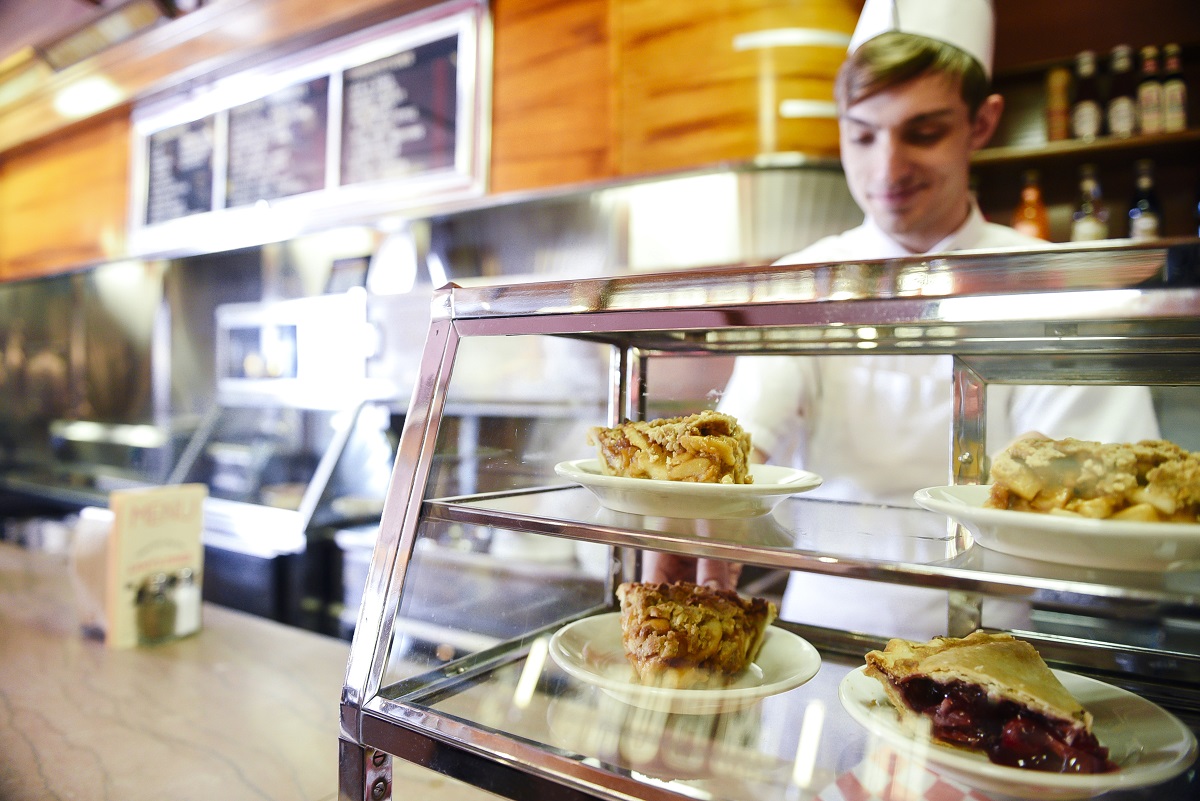 Photo by Emily Berger
Photo by Emily Berger
This month we are excited to reopen a guest favorite inside Henry Ford Museum of American Innovation: Lamy's Diner, a must-stop destination closed for almost two years during the COVID-19 pandemic. Operating as a restaurant inside the museum since 2012, Lamy’s provides members and guests an authentic 1940s diner experience, complete with chicken salad sandwiches and frappes. (And Toll House chocolate chip cookies, of course!)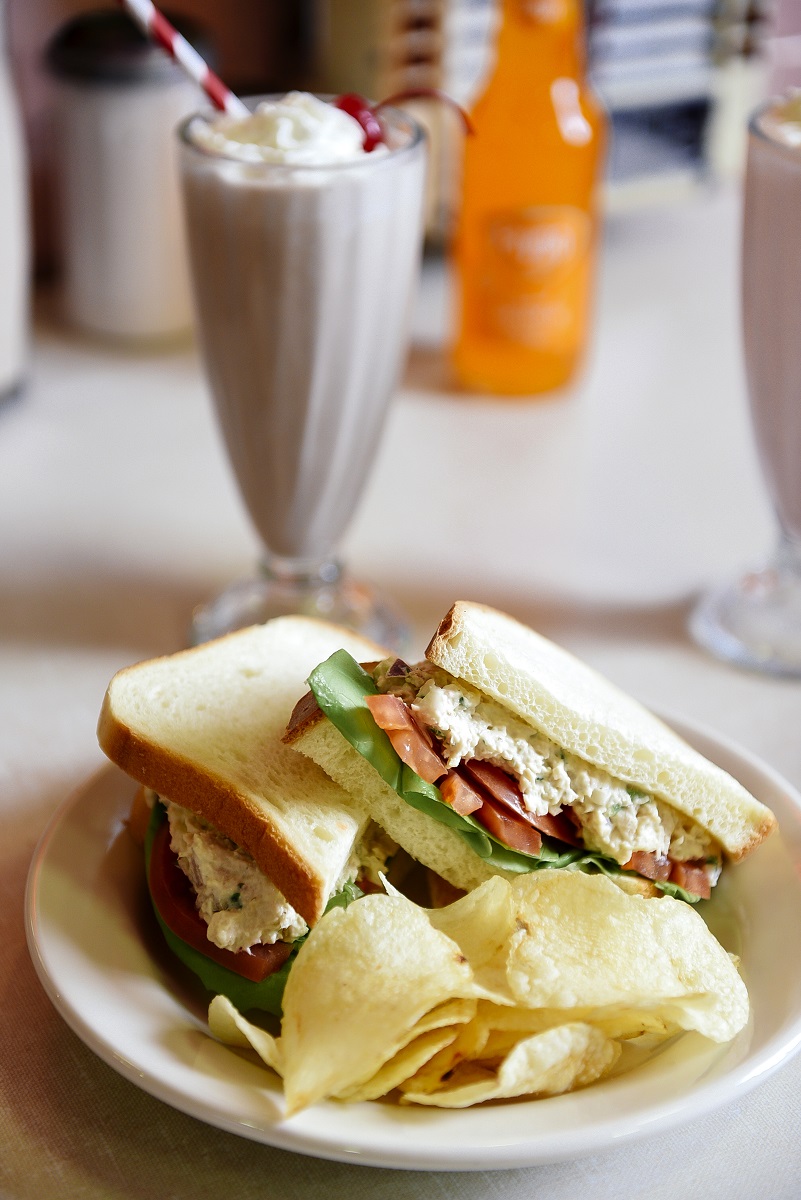
Photo by Emily Berger
In honor of Lamy’s reopening for daily dining, Eric Schilbe, Executive Sous Chef at The Henry Ford, shares two recipes that are crowd pleasers on the menu: tomato soup (an occasional special) and maple chicken salad. Try making these favorites at home, and then dig deeper into all-things Lamy’s in our Digital Collections.
Recipes
Lamy’s Tomato Soup
Makes about 4-5 bowls
Why we use this recipe:This is a very traditional tomato soup that has plenty of vegetable flavor and a touch of richness from the Parmesan cheese. (Psst! Don’t add the cheese until the very end!)
Ingredients
- 2T olive oil
- 1 large onion, diced
- 4 stalks small diced celery
- 2 carrots, chopped
- 1 bay leaf
- 1t dried basil
- 2 large cans diced tomato (plain – no seasoning)
- 1 cup half-and-half
- 1t pepper
- ¼ cup Parmesan cheese
Directions
- Cook the onions, carrots, and celery with oil in a stainless pot until completely tender.
- Add tomatoes, bay leaf, basil, and simmer about 30-40 minutes until completely cooked. (It should be a little darker than when you started.)
- Finish with half and half, Parmesan cheese, and pepper. Remove from heat.
- Using a blender, blend the soup until very smooth, and then serve immediately.
Chef’s Notes
- All canned tomatoes are not created equal! You may need to adjust with a little water or cook them down longer.
- Cook your vegetables until they are completely tender and falling apart—this will add richness to the flavor.
Lamy’s Maple Chicken Salad
Makes about 4-5 sandwiches
Why we use this recipe: Chicken salad can be such a simple recipe, but by adding maple syrup, a classic New England ingredient, and a touch of cumin, we set it apart from others.
Ingredients
- 2 large chicken breasts, cooked and cooled
- 4 stalks small diced celery
- ¼ minced red onion
- 1T yellow mustard
- 1T pure maple syrup
- ¼ cup mayonnaise
- 2T sour cream
- 1/4t cumin
- 1T fresh parsley, chopped fine
- 1t pepper
Directions
- Cook, cool, and pick the chicken. Place in a food processor and pulse until shredded fine.
- Add all other ingredients together and mix well.
- Let set, refrigerated, for 1-2 hours before serving.
Chef’s Notes
- During this era, the chicken was typically shredded very fine and simple ingredients were used. When making this at home, make sure the chicken is not overcooked and that it is very well shredded. This will make the salad moist and flavorful; you can always add a touch more mayonnaise.
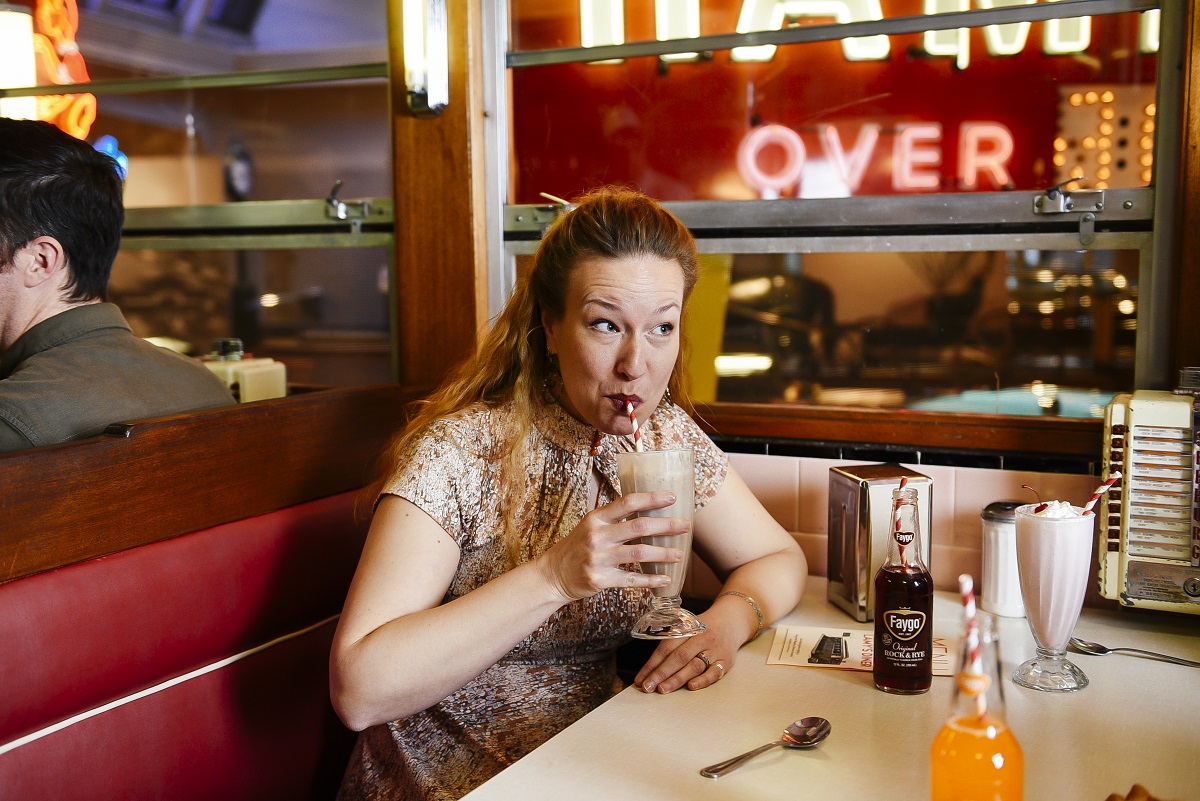
Photo by Emily Berger
Dig Deeper: Lamy's Online
All About Lamy’s
- Plan Your Visit: Lamy’s Diner (find notes on visiting and hours)
- Lamy’s Diner, 1946 (check out the Lamy’s artifact page in our Digital Collections)
- Lamy’s: A Diner from the Golden Age (explore the history of Lamy’s on our blog)
- Lamy’s Gets a Makeover (2017) (learn about our 2017 updates to Lamy’s menu; note that additional changes have been made since)
- Lamy’s on TV: Mr. Coffee – The Henry Ford’s Innovation Nation
Diners, Drive-Ins... and Cookies
- Diners: An American Original (dig into the history of the diner on our blog)
- Dig Deeper: Owl Night Lunch Wagon (explore artifacts related to Greenfield Village’s own Owl Night Lunch Wagon)
- Inventing America’s Favorite Cookie (find out how America’s favorite cookie, the Toll House chocolate chip cookie, was born)
- Flipping Burgers into a Career (learn the story of Don Dunivent, who worked for White Castle from the 1920s through the 1950s)
- Dig Deeper: Lunch Wagons (check out artifacts related to lunch wagons in our Digital Collections)
More Historic Dining at The Henry Ford
- Creating the Eagle Tavern Dining Experience (go behind-the-scenes to learn how we developed the menu for Greenfield Village’s Eagle Tavern)
- Beyond the Peanut: Food Inspired by Carver (discover how agricultural scientist George Washington Carver’s own recipes provided inspiration for some of our recipes at A Taste of History and Plum Market Kitchen)
Lish Dorset is Marketing Manager, Non-Admission Products, and Eric Schilbe is Executive Sous Chef at The Henry Ford.
Additional Readings:
- Lamy's Diner
- Lamy's: A Diner from the Golden Age
- Lamy's Diner at Its Original Site in Marlborough, Massachusetts, circa 1946
- Diners: An American Original
COVID 19 impact, recipes, by Eric Schilbe, by Lish Dorset, food, Driving America, Henry Ford Museum, diners, restaurants
A Sort-of-Traditional New Year’s Day Tradition
In preparing for our temporary exhibit Light and Joy in the Holiday Season, The Henry Ford’s curators solicited artifacts, photographs, and stories from The Henry Ford’s staff, among others. Below is one of the stories that was shared for the New Year display case.
My personal, vegetarian version of hoppin’ john, a traditional Southern New Year’s Day meal, in 2013. / Photo courtesy Ellice Engdahl
Though I’ve now lived in metro Detroit for more than two decades, I spent my formative years in the South, growing up in Jacksonville, Florida—the largest city (in terms of square footage) in the contiguous United States, an area split by one of the few rivers in the country that flows north (the St. John’s), and the hometown of Lynyrd Skynyrd.
Neither of my parents were born in Jacksonville. My dad grew up in Pennsylvania, and my mom on Lookout Mountain in the small town of Fort Payne, Alabama. During the Vietnam War, my dad was drafted into the military and sent to Fort McClellan in Anniston, Alabama, to utilize his newly minted bachelor’s degree in architecture to work on base buildings. At that time, my mom was living in Anniston with her sister and her sister’s husband, who was also involved in architecture on the base. My parents met, secretly eloped, moved briefly to Pennsylvania after my dad was discharged, then moved to Jacksonville for a job opportunity for my dad just after I was born.
Being as close to Georgia as you can be and still be in Florida, Jacksonville is definitely the South—the “Bold New City of the South,” as police cars and road signs proclaimed. And Southern foodways predominated, even as economies and cultural traditions slowly became more global. My mother was a fantastic cook who combined her Alabama farm roots with Jacksonville’s traditions—I grew up eating fried okra, grits, redeye gravy, barbecue, boiled peanuts, greens, banana pudding, scuppernongs and muscadines, sweet tea, and pecan pie, and didn’t realize these things weren’t universally beloved, valued, or available until I moved to Michigan.
Greens are a common food in the South. Here, collard greens are de-spined and washed for use in hoppin’ john, 2011. / Photo courtesy Ellice Engdahl
One thing I don’t remember ever not having on New Year’s Day was hoppin’ john. The traditional version of the dish is black-eyed peas cooked in broth with onions and a bit of ham or pork, served over rice, often with greens and cornbread on the side. (We Southerners like our carbs.) I don’t know when or where my mother picked up the idea of serving hoppin’ john on New Year’s Day—one of my cousins did not know what hoppin’ john was when I asked her this year, so I am guessing it did not originate in Alabama. She may have learned about it from friends in Jacksonville who followed the tradition.
The reason this humble staple is eaten on New Year’s Day is for good luck—the greens are the color of money, the peas represent coins, and some people even say the color of the cornbread relates to gold. Some long-time family friends from Jacksonville still refer to their annual plate of hoppin’ john as their “luck and money.” But beyond that, it’s a cheap, filling, and delicious meal.
As near as I can recollect, my mom made it fairly traditionally. She might have thrown a hambone into the peas for extra flavor—at least, before I became vegetarian. After I became vegetarian, she would cook a tray of bacon separate from the peas, so that the meat-eaters in the family (e.g., everyone but me) could crumble some over to get their pork fix, while I could eat meat-free, or crumble on some vegetarian bacon.
Soaking black-eyed peas to use in hoppin’ john, 2011. / Photo courtesy Ellice Engdahl
When I moved to Michigan, I wanted to continue the tradition with a meat-free version, but also wanted to simplify preparation—cooking peas, rice, and greens all separately, along with cornbread, is a lot of work for one person, especially given that it is most delicious when it all gets mashed together on the plate in the end anyway.
My family tended to like our hoppin’ john peas on the soupy side—something in keeping with the Southern tradition of “pot likker,” where you eat the flavorful broth that forms when you cook vegetables in seasoned water. I also took inspiration from another simple dish my mother made often—“bean soup.” This was just dried beans (pretty much any kind) cooked with onions in broth until they were tender and beginning to fall apart. It might sound dull, but cooked slowly for a couple of hours, and finished with a substantial amount of butter…. Yum. Once it was clear a soup was the simplest way to go, it was a pretty easy logical next step to add the greens right into the soup, removing the hassle of cooking them separately.
Cooking a big batch (for eating and for freezing for later) of my version of hoppin’ john, 2015. / Photo courtesy Ellice Engdahl
Below is the recipe (insomuch as I have one) I came up with.
Vegetarian Hoppin’ John (Soup)
Ingredients:
1 lb. dried black-eyed peas
1-2 onions
1-2 bunches collard greens
Vegetable stock, broth, or bouillon
Butter
Vegetarian bacon (I use MorningStar Farms Veggie Bacon Strips)
Preparation:
Pick through the dried black-eyed peas carefully, discarding any brown ones and any stray pebbles. (In my experience, every bag of dried peas contains at least one rock. Though picking through them is tedious, it’s far better to find the pebble(s) with your fingers than your teeth.) Rinse the peas in a strainer, then add them to a large bowl and cover them with a lot of water. Cover the bowl with plastic wrap or foil and let the peas soak overnight. They will grow in size substantially, maybe double.
When you’re ready to make the soup the next day, drain the peas, discarding the soaking water, and rinse them again.
Chop the onions and sauté them in a stockpot in some of the butter until partially softened, then add veggie stock and the soaked peas. Bring to a boil, then reduce to a simmer. Cook until the peas are nearly soft, stirring from time to time, usually one to two hours.
While the peas are cooking, de-spine, wash, and chop the collard greens into bite-sized pieces. When the peas are about half to three-quarters cooked, add the greens to the stockpot, and continue cooking until they are tender. Add additional butter to the soup to taste. (You could also add salt/pepper if desired, but usually the vegetable broth adds plenty of both.)
Cook the veggie bacon according to package directions. Serve up the soup, and crumble a strip or two of veggie bacon on each serving. Enjoy!

The finished product, vegetarian hoppin’ john soup, in 2011. / Photo courtesy Ellice Engdahl
Cornbread on the side is pretty much required. My mom made her own dry mix, which she combined with milk, eggs, and (if vegetarians weren’t present) bacon grease to bake, but since I don’t have her recipe, I just (somewhat shamefully) use the one off the back of the Quaker cornmeal package—though I use less sugar, replace the cow’s milk with plant-based milk, and replace the oil with melted butter—so I guess I’ve modified that as well.
I always make a double batch of hoppin’ john and cornbread and stash the remainder in the freezer to get me through the rest of the cold Michigan winter. It just gets better as you reheat it and the flavors continue to meld.
Snowy Michigan on New Year’s Day, 2014. Hoppin’ john freezes really well so it’s wise to make enough to get you through a Michigan winter. / Photo courtesy Ellice Engdahl
Vegetarian hoppin’ john (soup) might not be the most common tradition, especially in Detroit—but it’s a sign of the times that you can find a vegan version today at Detroit Vegan Soul. But the most satisfying version is the one you make yourself—and make your own.
Ellice Engdahl is Digital Collections and Content Manager at The Henry Ford.
20th century, Michigan, Florida, 21st century, 2010s, recipes, home life, holidays, Henry Ford Museum, food, by Ellice Engdahl
Native Flavors Trailblazer: Chef Brian Yazzie
Catch a glimpse of Brian Yazzie’s left arm, and you’ll see cranberries, sumac, and sunflowers near his wrist, blue Hopi corn on his forearm and Navajo squash holding court at his elbow. An illustrated sleeve of more produce and wild game are up next for the right.
Chef Brian Yazzie. / Photo courtesy Brian Yazzie
The inspiration behind the ever-growing tattooed bounty of Native American produce started at age 7 for Yazzie, when the aromatics of Navajo blue corn mush or the sound of a knife tapping on a cutting board drew him into the kitchen to help cook for his large family. Raised by a single mother in Dennehotso, Arizona, located on the northeast part of the Navajo Nation, Yazzie remembers eating traditional and freshly foraged foods like wild spinach and pine nuts but also commodity foods like government cheese, canned chicken, and powdered milk.
“That was what we grew up on,” said Yazzie. “But for me, as long as we had food, we were OK.”
He discovered his passion for cooking but at the time was equally lured into gang life, spending his teenage years in and out of detention centers and county jails and skipping classes, sometimes to just hide out in the home economics classroom.
“I was blessed never to end up in prison or passing on,” said Yazzie, whose sisters would call to tell him to come home because they missed his food. “That was their way of checking up on me. Cooking always kept me out of trouble; it’s what saved my life.”
It’s also what prompted Yazzie and his wife, Danielle Polk, to settle in the Twin Cities in 2013. They wanted opportunity but also to stay connected to Native communities. “The Twin Cities has one of the top five Native urban populations in the U.S.,” said Yazzie, who works closely with the Dakota and Ojibwe tribes there while continuing to help the Dennehotso reservation and other tribal communities around the United States.
In 2014, Yazzie enrolled at Saint Paul College, where his first assignment as a culinary student was to perfect any dish from around the world. “I wanted to make something beyond frybread, but I realized at least 50% of ingredients inside Navajo tacos are native to the Americas,” said Yazzie.
Toppings like summer squash, peppers, and eggplant reminded him of French ratatouille, and he found his dish. More importantly, he discovered the larger influence of Indigenous foods and his passion for reviving, celebrating, and recognizing their ancestral origins.
Chef Yazzie found inspiration in eggplant, summer squash, and peppers, like the one on this circa 1951 seed packet from our collection, during his first assignment as a culinary student. / THF294269
He and Polk started a Native American Club on campus and connected with local chef/author/educator Sean Sherman, CEO of The Sioux Chef, to cater one of their events. “Seventy-five percent of the appetizers he served were foreign to me,” said Yazzie, who went on to work for Sherman before he and Polk started their own catering company, Intertribal Foodways. “We wanted to bring awareness to what’s been overlooked for so long.”
Along with showcasing Native ingredients and techniques, that’s also meant addressing health issues like diabetes that have long affected Indigenous communities. “We try to implement food as medicine,” said Yazzie, now executive chef of the Gatherings Cafe inside the Minneapolis American Indian Center. “Especially during this pandemic, we have to keep our elders strong and safe; a lot of them hold lost languages and teachings.”
After COVID-19 hit, Yazzie and his team started making 200 healthy meals a day for elders in the Twin Cities, established a Dennehotso COVID-19 relief fund, and regularly sent healthy food and supplies to the Apache County community. He works with local farmers and foragers to bring Native ingredients into his food whenever he can, even if it means taking baby steps with dishes like unhealthy frybread (created by Yazzie’s Navajo ancestors while they were in internment camps at Fort Sumner, New Mexico, in the 1860s). “It’s still on the table across North America as a survival staple for tribal communities, especially during the pandemic, so I had to take a step back and listen to my elders, but we’re getting there,” said Yazzie, who lightens up the wheat-heavy bread with amaranth flour or wild rice flour.
Continue Reading
21st century, 2020s, Indigenous peoples, The Henry Ford Magazine, restaurants, recipes, healthcare, food insecurity, food, COVID 19 impact, by Liz Grossman

